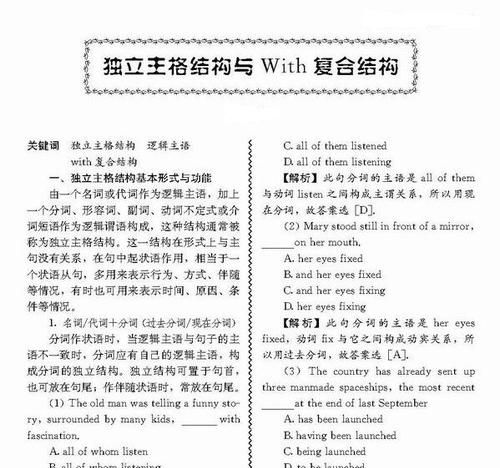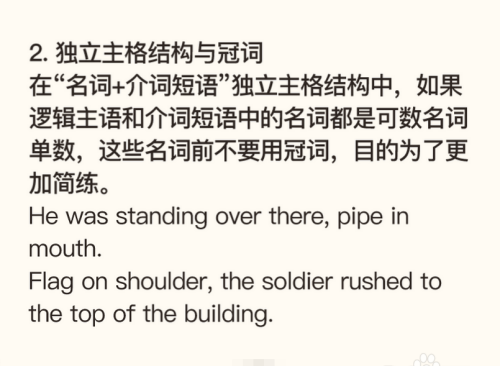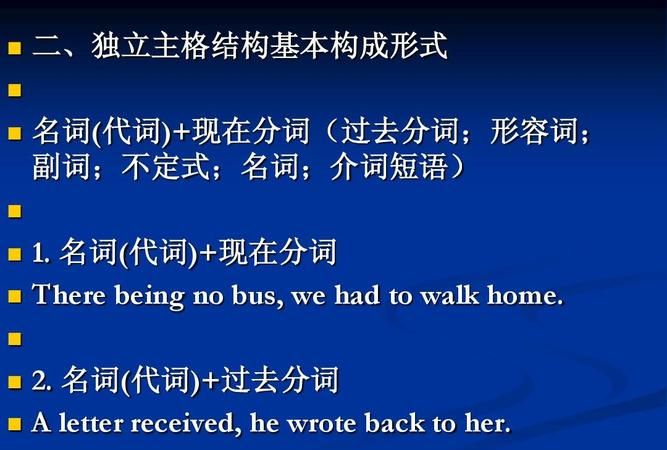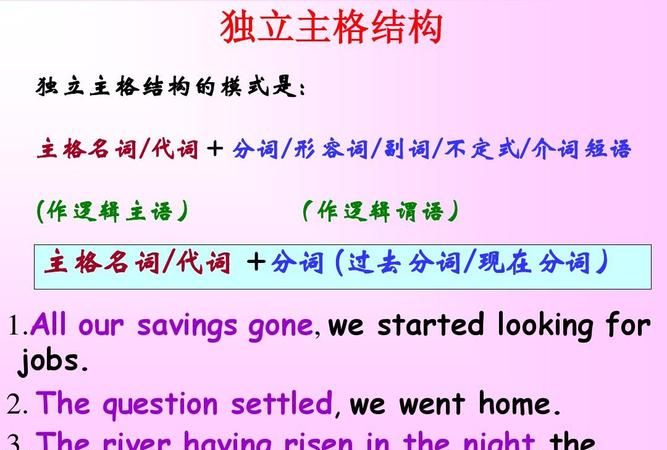本文目录
独立主格的结构是怎样的
独立主格结构中的名词或代词与其后的分词等构成逻辑上的主谓关系。这种结构与主句不发生句法上的联系,它的位置相当灵活,可置于主句前、主句末或主句中,常由逗号将其与主句分开。需特别注意的是,独立主格结构与主句之间不能使用任何连接词。 二、独立主格结构基本构成形式
名词(代词)+现在分词(过去分词;形容词;副词;不定式;名词;介词短语) 1. 名词(代词)+现在分词Night enshrouding the earth, nobody could make out what the dark mass was from a distance.黑夜笼罩大地,谁也看不清远处黑压压的一片是什么东西。There being no bus, we had to walk home.由于没有公共汽车,我们只好走回家。 2. 名词(代词)+过去分词The workers worked still harder, their living conditions greatly improved.由于工人们的生活条件大大提高,他们工作得更起劲了。He was listening attentively in class, his eyes fixed on the blackboard. 他上课专心听讲,眼睛紧盯着黑板。 3. 名词(代词)+不定式在“名词/代词+动词不定式”结构中,动词不定式和它前面的名词或代词如果存在着逻辑上的主谓关系,动词不定式则用主动的形式;如果是动宾关系,则用被动形式。The four of us agreed on a division of labor, each to translate a quarter of the book.我们四人同意分工干,每人翻译全书的四分之一。Many trees, flowers, and grass to be planted, our newly-built school will look even more beautiful.种上许多的树、花和草后,我们新建的学校看上去将更美。 4. 名词(代词)+形容词The Trojans asleep, the Greek soldiers crept out of the hollow wooden horse.特洛伊人睡着了,于是希腊士兵从中空的木马里悄悄爬了出来。Computers very small, we can use them widely.电脑虽小,我们却能广泛地利用它们。 5. 名词(代词)+副词The meeting over, our headmaster soon left the meeting room.散会了,校长很快就离开了会议室。The lights off, we could not go on with the work.灯熄了,我们不能继续工作了。 6. 名词(代词)+名词His first shot failure,he fired again.他第一枪没击中,又打了一枪。Two hundred people died in the accident, many of them children.两百人死于事故,其中有许多儿童。 7. 名词(代词) +介词短语He lay at full length upon his stomach,his head resting upon his left forearm.他的脊背朝天,四肢伸展,头枕着左臂,直挺挺地趴伏着。Every afternoon a very old woman hobbled past the old house,a vast load of firewood on her back.每天下午,一个背着一大背柴禾的老妇人都会从那间破旧的房屋前蹒跚着走过。 三、with,without 引导的独立主格结构 with ( without)+宾语(名词/代词)+宾语补足语,宾语通常由名词或代词充当,但代词一定要用宾格。上文的独立主格结构的几种情况都适用于此结构。The girl hid her box without anyone knowing where it was.小女孩把盒子藏了起来,没有人知道它在哪里。(without +名词/代词+动词的-ing形式) Without a word more spoken, she left the meeting room.她没再说什么话就离开了会议室。(without+名词/代词+动词的-ed形式) The kid feels excited with so many places of interest to visit.有这么多的名胜可参观,小孩很激动。(with+名词/代词+动词不定式) The boy was walking, with his father ahead. 父亲在前,小孩在后走着。(with+名词/代词+副词) He stood at the door, with a computer in his hand. 或He stood at the door, computer in hand. 他站在门口,手里拿着一部电脑。(with+名词/代词+介词短语)With his son so disappointing, the old man felt unhappy.由于儿子如此令人失望,老人感到很不快乐。(with+名词/代词+形容词)在with (without) 的复合结构中,多数情况下with 能省略,但without 不能省略。 四、独立主格结构的句法功能 独立主格结构在句中一般作状语,表示时间、条件、原因、伴随状况等,还可以作定语。 1. 作时间状语 My shoes removed,I entered a low-ceilinged room,treading cautiously on the soft tatami matting.我脱掉鞋子后,走进一间屋顶很低的房间,小心翼翼地踩在柔软的塌塌米垫子上。 The governor pondering the matter,more strikers gathered across his path.总督思考问题时,更多的罢工工人聚集在他要通过的路上。 2. 作条件状语 Weather permitting,they will go on an outing to the beach tomorrow.如果天气允许的话,他们将在明天组织一次海滨郊游。 Such being the case,you have no grounds for dismissing him.如果情况如此的话,你没有理由解聘他。 3. 作原因状语 The boy leading the way, we had no trouble finding the strange cave.由那个男孩带路,我们很容易就找到了那奇怪的洞。 There being no further business to discuss, we all went home.没有别的事可讨论,我们都回家了。 4. 作伴随状语或补充说明 I took my ticket,and marched proudly up the platform,with my cheeses,the people falling back respectfully on either side.我拿着车票还有我的奶酪,雄赳赳气昂昂地跨步走向月台。人们似乎很尊敬我,纷纷向两边退去。 Ten students entered for the competition, the youngest a boy of 12.十个学生报名参加了这次竞赛,年纪最小的是个12岁的男孩。 5. 作定语,独立主格结构作定语其功能相当于一个定语从句。 He is the person with a lot of questions to be settled.他就是有许多问题要解决的那个人。He was walking along the road without any street lights on its both sides.他走在一条两边没有路灯的马路上。 Close to the bank I saw deep pools, the water blue like the sky.靠近岸时,我看见几个深池塘,池水碧似蓝天。 五、独立主格结构注意事项 1. 独立主格结构多用于书面语,尤其是描述性语言中,在口语和非正式文体中,一般用从句或两个句子来代替。独立主格结构的逻辑主语与句子的主语不同,它独立存在,名词或代词与后面的分词等逻辑上是主谓关系,独立主格结构一般有逗号与主句分开。 The president assassinated, the whole country was in deep sorrow.总统被谋杀了,举国上下沉浸在悲哀之中。 2. 动词不定式表示动作没有发生或即将发生,动词-ed形式表示动作已经结束,动词-ing形式往往表示动作正在进行。 The manager looks worried,many things to settle.经理看上去很着急, 有这么多的事情要处理。(事情还没有处理,而且是由经理本人来处理,用不定式to settle,表示将来的时间) The manager looks relaxed, many things settled.许多事情已经处理好了,经理看上去很轻松。(事情已经处理好了,用过去分词settled表示动作已经结束) The food being cooked, the boy was watching TV.小孩一边做饭,一边看电视。(两个动作同时进行) 3. 独立主格结构介词使用的问题当介词是in时,其前后的两个名词均不加任何成分(如物主代词或冠词),也不用复数。但 with 的复合结构不受此限制。 A robber burst into the room, knife in hand. ( hand前不能加his)劫匪手里拿着刀闯进房间。 当表人体部位的词做逻辑主语时,及物动词用现在分词,不及物动词用过去分词。 He lay there, his teeth set, his hands clenched, his eyes looking straight up.他躺在那儿,牙关紧闭,双拳紧握,两眼直视上方。 4. 独立主格结构与独立成分的异同 有些分词短语可以独立存在,在句子中没有逻辑上的主语,作为习惯用法。这些短语有:Generally speaking (总的说来),Frankly speaking (坦率地说),Judging from (从……判断),Supposing (假设),等等。 Generally speaking, the rule is very easy to understand.总的说来,这条规则很容易懂。Judging from what he said, he must be an honest man.由他所说的来判断,他一定是一个诚实的人。有些固定短语是带 to 的不定式,表明说话人的立场或态度,在句中作独立成分。这些短语有:to be honest(老实说),to be sure (确实),to tell you the truth (说实话),to cut a long story short (长话短说),to be frank (坦率地说),to make matters / things worse (更糟糕的是),等等。 To tell you the truth, I made a mistake in the word spelling. 说实话,我犯了一个拼写错误。 To make things worse, many of the men have gone off to cities in search of higher pay, leaving women from nearby villages to carry on with the work. 情况更糟的是,许多男人都去城市找工资较高的工作,而留下附近村庄的妇女来继续承担修复工作。 5.独立主格结构与分词短语都可以转换为状语从句。但是独立主格结构转换为状语从句后,它有自己的逻辑主语,与主句的主语不一致;而分词短语转换为状语从句后,从句的主语与主句的主语一致。If time permits, we'd better have a holiday at weekends.转换为:Time permitting, we'd better have a holiday at weekends. 如果时间允许,我们最好周末去度假。 When we see from the hilltop, we can find the city more beautiful.转换为:Seeing from the hilltop, we can find the city more beautiful. 从山顶上看,我们发现这个城市更美了。还必须注意,分词结构的逻辑主语并不总是和主句的主语一致,也可以是主句的其他成分。

英语中独立主格的用法
独立主格结构是由一个相当于主语的名词或代词加上非谓语动词、形容词(副)词、或介词短语构成的一种独立成分。该结构不是句子,也不是从句,所以它内部的动词不能考虑其时态、人称和数的变化,它与其主句之间既不能通过并列连词连接也不能有从句引导词引导,常用逗号与其主句隔开。独立主格结构在很多情况下可以转化为相应的状语从句或其他状语形式,但很多时候不能转化为分词形式,因为它内部动词的逻辑主语与主句主语不一致。在做这类题目时一定要小心判断,不能粗心大意。
一、独立主格结构的构成形式
独立主格结构的构成方式为:名词普通格或代词主格+现在分词/过去分词/不定式/名词/形容词/副词/介词短语等。使用独立主格结构是因为出现了与句子主语不一致的情况。
1. 名词或代词+现在分词
现在分词表示前面的名词或代词主动进行的动作或状态。如:
The man lay there, his hands trembling.
那个男子躺在那儿,双手在颤抖。
有时,现在分词being或having been在独立主格结构中可以省略。如:
The weather (being) fine,we decided to go swimming.
天气晴朗,我们决定去游泳。
2. 名词或代词+过去分词
过去分词表示前面的名词或代词被动完成的动作。如:
The girl sat there silent,her head bent low.
这姑娘一声不响,低着头坐在那里。
All things considered, her paper is of greater value than yours.
各方面考虑起来,她的论文比你的论文更要有价值一些。
3. 名词或代词+不定式(短语)
不定式表示将来的动作。如:
He suggested going for a picnic,Mary to provide the food.
他建议去野餐,由玛丽负责提供食物。
Time is pressing, two hours to go only.
时间紧迫,只剩两个小时了。
4. 名词或代词+名词(短语) 如:
Many people joined in the work, some of them women and children.
许多人参加了这项工作,其中一些人是妇女和儿童。
5. 名词或代词+形容词(短语)
形容词(短语)说明前面名词或代词的性质或状态。如:
The floor wet, we had to stay outside for a while.
地面很湿,我们只好在外面呆一会儿。
6. 名词或代词+副词
副词也多是说明前面名词或代词的状态。如:
The meeting over, we all went home.
会议结束了,我们都回家了。
7. 名词或代词+介词短语 如:
The teacher came in, a book in his hand.
老师进来了,手里拿着一本书。
有时,独立主格结构中名词前面的定语可以省略。如:
The boy lay silently on the grass, (his) eyes closed.
A girl was walking in the street, (a) flower in (her) hand.
二 独立主格结构的作用
1. 作状语
1) 表示时间 如:
Her homework done (=After her homework was done),Lucy decided to go shopping.
2) 表示原因 如:
There being no buses (Because there were no buses),we had to walk home.
3) 表示条件 如:
Weather permitting (If weather permits), we will go to play football.
4) 表示方式或伴随 如:
He rushed into the room, his face covered with sweat.
2. 作同位语 如:
There are two doors, one leading to the bedroom, the other (leading) to the kitchen.
三 独立主格前面有时可以加上介词with或without,构成介词的复合结构。这种结构在句中主要用作状语,也可用作定语。如:
He stood on the deck with his hand waving to us.(状语)
他站在甲板上向我们频频挥手。
He went out without a hat on his head.(状语)
他头上没戴帽子就出去了。
Do you know the girl with a bag on her back?(定语)
你认识那个后背上背包的女孩吗?

独立主格的用法
独立主格结构是一个独立主格的名词或代词(作为逻辑主格),加上一个分词、形容词、副词、不定式、介词短语。其作用相当于状语,多用来表示行为、方式或伴随的情况,有时也用来表示时间和条件。这种结构多用在书面语中。
一、几种常见的独立主格结构形式
1.名词(或代词)+现在分词(或过去分词)。如:
1)The moon appearing,they decided to go on with theirjouney.
2)Good-bye said,he went home.
2.名词(或代词)+形容词。如:
3)The weather(being)hot,we all went swimming.
3.名词(或代词)+不定式。如:
4)Some of the money to be paid by the thief, the policewent.
4.名词(或代词)+介词短语。如:
5)He climbed in,sword in hand.
5.名词(或代词)+副词。如:
6)The meeting(being)over, we left the room.
独立主格结构的模式是:
主格名词/代词 + 分词/形容词/副词/不定式/介词短语
(作逻辑主语) (作逻辑谓语)
1. All our savings gone, we started looking for jobs.
2. The question settled, we went home.
3. The river having risen in the night, the crossing was impossible.
主格名词/代词 + 分词 (过去分词/现在分词)
主格名词/代词 + 形容词
1. His mother being ill, he had to stay home to look after her.
2. Other things being equal, I would buy the black dress.
主格名词/代词 + 副词
The meeting being over, our headmaster soon left
the meeting-room.
We to care for the children, you are able to be carefree
away from home.
主格名词/代词 + 不定式
主格名词/代词 +介词短语
Our English teacher came into the classroom, papers in hand.
with复合结构 与 独立主格结构
它们都可以在句中作原因状语,伴随状况状语,条件状语,时间状语或结果状语用,一般也可以相互转换.虽然它们的语法功能和意义相同,但其结构形式和名称却不相同.
with复合结构的模式是:
with+名词/代词+分词/形容词/副词/不定式/介词短语
独立主格结构的模式是:
主格名词/代词+分词/形容词/副词/不定式/介词短语
一,作时间状语
1,With winter coming on, the trees turn yellow and
some birds fly south.
=Winter coming on, the trees turn yellow and some
birds fly south.
二,作原因状语
1,With the weather terribly cold, we entered the
room to warm ourselves.
= The weather terribly cold, we entered the room to warm ourselves.
2,With the key having been lost, she could not
enter the room.
= The key having been lost, she could not enter the room.
三,作条件状语
1,With time permitting, we'll visit the Summer Palace.
= Time permitting, we'll visit the Summer Palace.
2,With the car going wrong, we'll have to stop
at the foot of the mountain.
= The car going wrong, we'll have to stop at the foot
of the mountain.
四,作伴随状语
1,The mother was cleaning the house with her baby
playing on the bed.
=The mother was cleaning the house, her baby playing
on the bed.
2,Last night I followed him, with a sword in my hand.
= Last night I followed him , sword in hand.
无论with复合结构还是独立主格结构,都不可有动词的谓语形式充当其中的逻辑谓语.如下例中的was就必须去掉:
He sat at the desk reading
with a pen was in his right hand.
with复合结构可以作后置定语修饰名词,而独立主格结构则不可作后置定语修饰名词.
Soon she arrived at a park with grass green and
flowers in blossom.
= Soon she arrived at a park whose grass was green
and whose flowers were in blossom.

什么是独立主格结构
“独立主格结构”是由名词或代词作为主语。
“独立主格结构”在句中的功能就相当于一个带有自己主语的状语从句。众所周知非限制性从句通常以主句的某一成分作为自己的逻辑主语,从而依附于主句。而有些非限制性从句和无动词从句带有自己的主语,在结构上与主句不发生关系,因此成为独立主格结构。其实,虽然叫做独立主格结构,并不是真正的独立,它还是一种从属分句,在句中有多种作用。如:表原因、表条件、表方式、表伴随、表时间等,在句中通常起状语作用。有时还可以做定语 。
独立主格结构主要用于描绘性文字中,其作用相当于一个状语从句,常用来表示时间、原因、条件、行为方式或伴随情况等。例如:
1) 表示时间
The meeting being over, all of us went home. 开完会后我们都回家了。the meeting being over相当于when the meeting was over
Her work done, she sat down for a cup of tea. 她干完了活,坐下来喝茶。her work done相当于when her work was done
2) 表示条件
The condition being favorable, he may succeed. 若条件有利,他或许能成功。the condition being favorable相当于If the condition is favorable
3) 表示原因
There being no taxis, we had to walk. 没有出租车,我们只好步行。There being no taxis相当于Since there was no taxis,
He wrapped her up with great care, the night being dark and frosty. 夜又黑又冷,所以他把她裹得严严实实的。as the night was dark and frosty
4) 表示伴随情况
Almost all metals are good conductors, silver being the best of all. 几乎所有的金属都是良导体,而银则是最好的导体。(=Almost all metals are good conductors,and silver is the best of all.)
5) 表示补充说明
We redoubled our efforts, each man working like two. 我们加倍努力,一个人干两个人的活。
*注:独立主格结构表示时间、条件或原因时,相当于一个状语从句,一般放在句首,表示原因时还可放在句末;表伴随状况或补充说明时,相当于一个并列句,通常放于句末。
特点
(1)独立主格结构的逻辑主语与句子的主语不同,它独立存在。
(2)名词或代词与后面的分词,形容词,副词,不定式,介词存在逻辑上的主谓关系,即逻辑主语为动作执行者。
(3)独立主格结构一般有逗号与主句分开。(不绝对)
3类型编辑
独立主格类型1:名词(代词)+现在分词
The question being settled, we went home.问题解决之后,我们就回家了。
We shall play the match tomorrow, weather permitting. 明天假设天气好,我们就进行比赛。
The monitor being ill, we’d better put the meeting off. 班长病了,我们最好还是延期开会吧。
独立主格类型2:名词(代词)+过去分词
The job finished, we went home. 工作结束后我们就回家了。
The last bus gone, we had to walk home. 最后一班公车已经走了,我们必须走路回家。
More time given, we should have done the job much better. 如果给我们更多的时间,我们会把工作做得更好。
独立主格类型3:名词(代词)+不定式
Nobody to come tomorrow, we will have to put off the meeting till next week. 如果明天没有人来,我们将把会议推迟到下周。
So many people to help him, he is sure to succeed. 有如此多的人来帮助他,他一定会成功的。
独立主格类型4:名词(代词)+介词短语
The soldiers dashed in, rifle in hand. 士兵们端着枪冲了进来。
A girl came in, book in hand. 一个少女进来了,手里拿着书。
He was waiting, his eyes on her back. 他在等着,眼睛望着她的背影。
独立主格类型5:名词(代词)+形容词或副词
He sat in the front row, his mouth half open. 他坐在前排,嘴半开着。
She sat at the table, collar off, head down, and pen in position, ready to begin the long letter. 她坐在桌前,衣领已解掉,头低了下来,拿好钢笔,准备开始写一封长信。
独立主格类型6:There being +名词(代词)
There being nothing else to do, we went home. 没有别的事可做,我们就回家了。
There being no further business, I declare the meeting closed. 没有再要讨论的事了,我宣布散会。
独立主格类型7:It being +名词(代词)
It being Christmas, the government offices were closed. 由于圣诞节的缘故,政府机关都休息。
It being a holiday, all the shops were shut. 由于今天是假日,所有商店都关门了。

以上就是关于名词独立主格用法 ,独立主格的结构是怎样的的全部内容,以及名词独立主格用法 的相关内容,希望能够帮到您。

